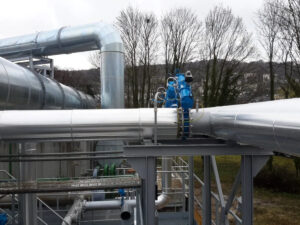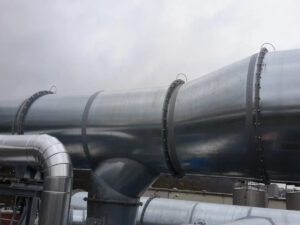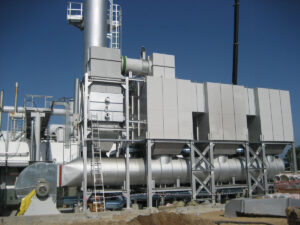Recuperative thermal oxidisers provide an efficient solution for the treatment of VOC emissions, thanks to the integration of a thermal recovery section that pre-heats the polluted effluent before it is fed into the combustion chamber. This mechanism significantly reduces fuel consumption and optimises operating costs.
In some cases, it is possible to implement a second heat recovery stage to heat service fluids (thermal oil, water, air, etc.), providing further energy savings.
Recuperative Oxidizers: features and benefits
- High depuration efficiency: >99,9%.
- High energy efficiency with optimised heat recovery system.
- Independent, modulating combustion system to adapt to different pollutant loads.
- Combustion chamber with refractory materials to ensure longer system life even in heavy-duty applications.
- Possibility of additional heat recovery.
- Ease of handling and use.
- Advanced telematics management with PLC and remote assistance.
Principle of operation of Recuperative Oxidizers
Thermal recuperative oxidisers, unlike direct thermal oxidisers, integrate a heat exchange section downstream of the combustion chamber, where the purified flue gases pre-heat the incoming polluted air.
Depending on the industrial application, the heat recovery section can be:
✔ Integrated and coaxial to the combustion chamber
✔ Independent and located downstream the combustion chamber
Both solutions ensure high performances and can be chosen according to the type of industrial process.
These systems are designed for high energy efficiency, significantly reducing fuel consumption and optimising overall energy requirements. The installation of additional heat exchangers allows additional energy to be recovered for heating service fluids, with a positive impact on operating costs.
Regenerative thermal oxidizers with pre/post treatment
To handle complex pollutants and to ensure maximum plant efficiency, thermal oxidizers can be equipped with pre- and post-treatment systems.
✔ Pre-treatments
Pre-treatments are used to shield the oxidizer from pollutants that could jeopardize its functioning, e.g. silicon organic compounds, inorganic acids, inorganic bases, aerosol and dust. The solutions include:
- Cyclones
- Bag or cartridge filters
- Venturi and tower scrubbers
- Filtering panels
- Activated carbon adsorbers
- Filters for the removal of oily mists
✔ Post-treatments
Post-treatments are necessary when the effluent exiting the oxidizer needs further treatment to reduce specific undesired compounds, such as halogenated VOCs, sulphurates or siloxanes. Available technologies include:
- Quencher for rapid cooling
- Tower scrubbers, specifically designed for the abatement of acids and bases, ensuring pollutants neutralization before the final discharge
- Selective abatement systems to reduce specific emissions, including deNOx systems to reduce nitrogen oxides (NOx) produced during the oxidation process. DeNOx technologies include
- SCR (Selective Catalytic Reduction) with the injection of reagents such as ammonia or urea using catalytic support
- SNCR (Selective Non-Catalytic Reduction) with the injection of reagents such as ammonia or urea
Thanks to these integrations, Brofind® oxidizers ensure high performances and maximum reliability even with complex and variable flows.
Electric thermal oxidizers – OxyTherm® eco2
Brofind® offers fully electric solutions, cutting the use of fossil fuels and ensuring:
✔ Zero CO2 emissions from fuel
✔ High energy efficiency with heat recovery
✔ Compact dimensions and easy installation
✔ Reliability and reduced maintenance
Typical applications and target sectors
Thermal recuperative oxidisers find application in various industrial sectors that require efficient treatment of pollutant emissions, particularly in processes that generate high concentrations of VOCs or hazardous organic compounds. The main areas of use include:Thermal recuperative oxidisers find application in various industrial sectors that require efficient treatment of pollutant emissions, particularly in processes that generate high concentrations of VOCs or hazardous organic compounds. The main areas of use include:Thermal recuperative oxidisers find application in various industrial sectors that require efficient treatment of pollutant emissions, particularly in processes that generate high concentrations of VOCs or hazardous organic compounds. The main areas of use include:
- Chemical industry
- Pharmaceutical sector
- Painting and coatings
- Rubber and plastic production
- Waste treatment
- Food industry
These systems are particularly effective in a variety of production environments, ensuring compliance with the most stringent environmental regulations and significant energy recovery.
Customized plant solutions
- Development of pre-treatment sections for pollutants with silicon content (silanes, siloxanes) or dust-containing streams
- Implementation of special alloy exchangers for corrosive gases
- High concentration management system for high pollutant load applications
- Secondary heat recovery with dedicated energy-saving solutions
- Use of low-emission burners to minimise environmental impact (LowNOx)






